Rocky Mountain National Park is definitely a bucket list destination. With tall peaks, alpine lakes, and tons of wildlife, it’s a dream for families, couples, and solo travelers. We loved experiencing the park with our 5 little ones, and want to share some tips, tricks, and things to do in Rocky Mountain National Park with kids!
Whether you’re camping hiking, picnicking, stayed in a hotel, driving to viewpoints, or even just learning about the history of the park from home, I hope this Rocky Mountain National Park family guide is helpful and informative. You’ll find info on Rocky Mountain activities, lodging, and food, as well as indigenous history of the lands, book recommendations, and more – perfect whether you’ve never visited or whether you’ve been 100 times.
I hope you enjoy this Rocky Mountain vacation guide!
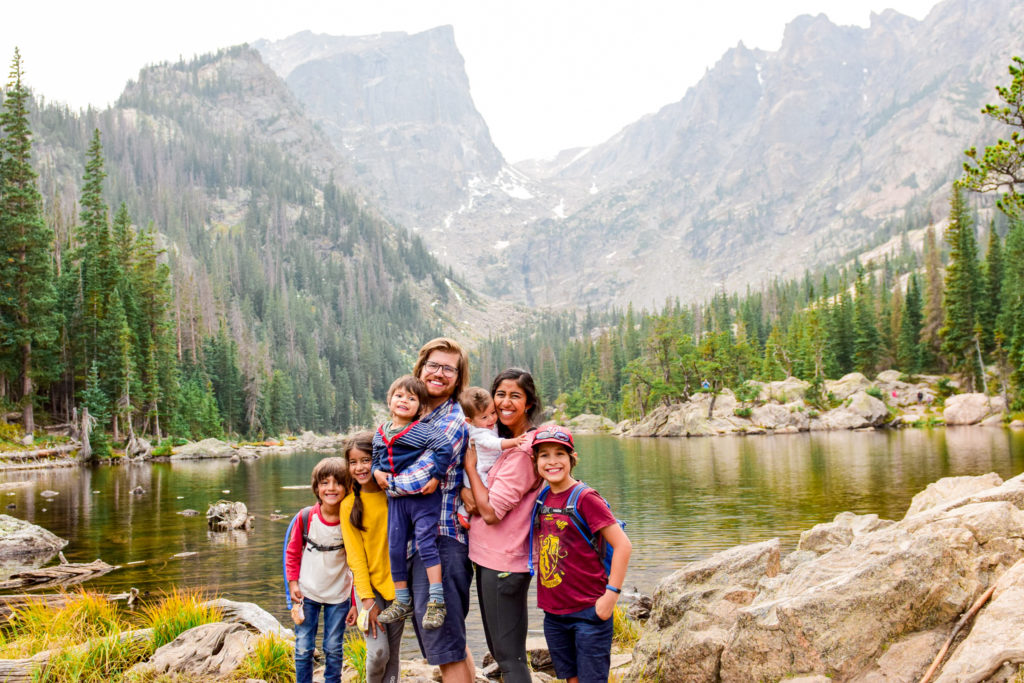
Table of Contents
Learn About Rocky Mountain National Park
Before we visit a national park, our family loves learning about it! It helps us enjoy it more and appreciate the people who have stewarded it well before us. We love learning the indigenous history, as well as about the wildlife and ecosystems.
Here are a few ways to learn about the park either before a visit or as a Rocky Mountain virtual tour!
Books About Rocky Mountain National Park
Featured Rocky Mountain Picture Book

High As A Hawk by T. A. Barron (Author), Ted Lewin (Illustrator)
Available on Amazon, Thriftbooks, Abebooks
Other Rocky Mountain National Park Books for Kids
Rocky Mountain National Park History & Natural Features
- Rocky Mountain National Park contains 77 peaks over 12,000 feet high.
- About 1/3rd of the park is alpine tundra (above the tree line in this part of Colorado).
- Trail Ridge Road is the highest continuously paved road in the United States.
- Nearly 95% of the park is designated wilderness, officially recognized with the Omnibus Public Lands Management Act of 2009.
- Source, Source
Indigenous History
- The primary indigenous tribes in the area prior to white colonization were the Utes and the Arapahos.
- Folsom peoples used the famous Lindenmeier site near RMNP around 11,000 years ago. They hunted a now-extinct bison called Antiquus that was larger than modern bison.
- The tribes moved from mostly nomadic to a primarily hunter-gatherer lifestyle.
- The Utes seemed to rely primarily on hunting & gathering instead of agriculture. While they probably were not always consumed by food acquisition, they likely had periods of hunger.
- Horses changed the Ute lifestyle, including housing and food acquisition.
- The Arapahos likely arrived in the late 1700s, and were often at war with the Utes. They were incredible nomadic hunters.
- White colonists arrived soon after the Gold Rush and made land promises to Indian tribes, most of which were not fulfilled.
- Less than 100 years after they arrived, the Arapaho had been almost entirely removed from Colorado due to white invasion.
- In the 1860s, Utes signed treaties that granted them the western 1/3rd of Colorado. However, when gold was discovered in the San Juan Mountains, they had to leave by 1873. They were then moved to just a tiny reservation in the southwest part of the state and had no claim on the rest of the land.
- (Source)
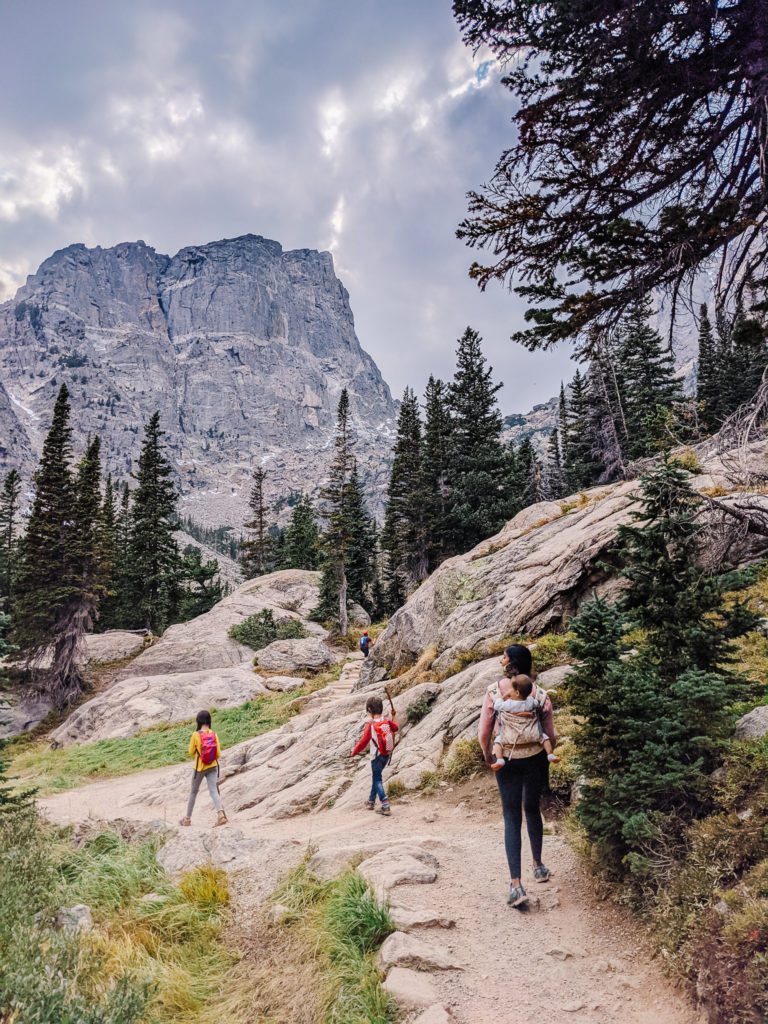
Animals in Rocky Mountain National Park
- Over 60 species of mammals live in the park, along with 280 bird species, 6 amphibians, and 1 reptile.
- There are also 11 species of fish and many kinds of insects and butterflies.
- Water ouzels have a loud sound that sometimes sounds like 2 stones clicking together.
- Otters were successfully reintroduced into the Colorado River area.
- 67 mammal species are known to be native to the area.
- 4 species are endangered or proposed threatened within the park: the Canada lynx, the Greenback cutthroat trout, the Mexican Spotted Owl, and the North American wolverine.
Rocky Mountain National Park Discussion Questions
- What is the highest place you’ve ever visited? What do you think it would feel like to stand on top of a mountain?
- Think about your ideal habitat. Would you prefer to live in an alpine tundra, or down in a meadow?
- Which animal in Rocky Mountain National Park would you like to learn more about?
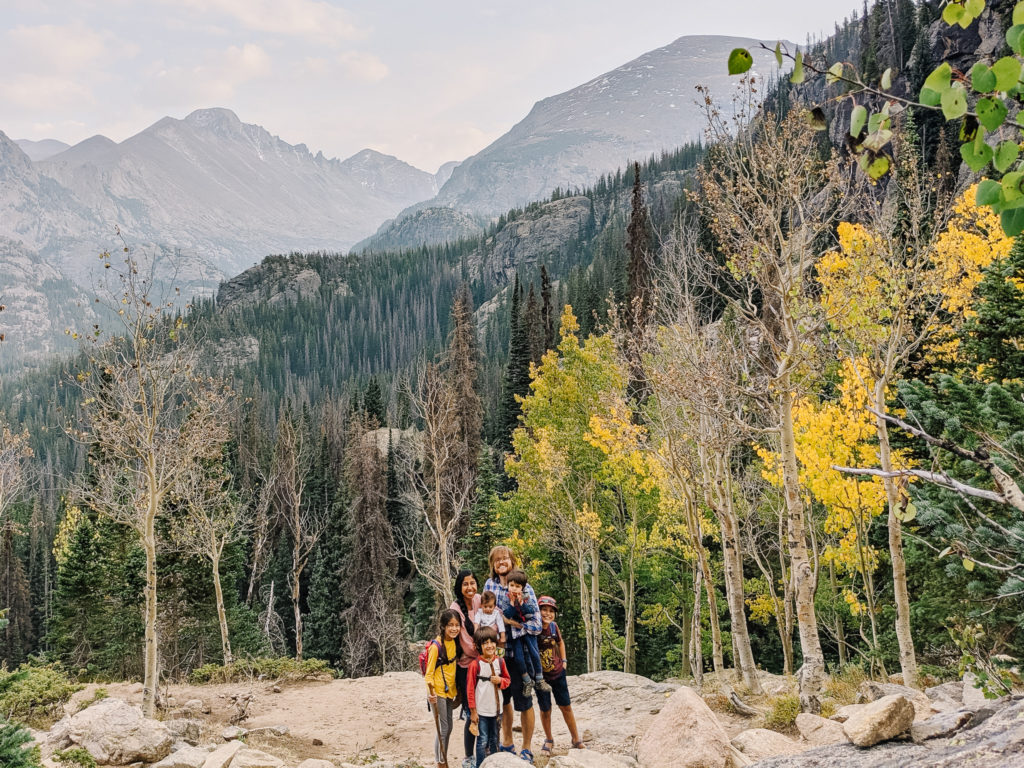
Rocky Mountain Packing List: What to Pack For a Rocky Mountain National Park Family Vacation
Rocky Mountain National Park weather varies quite a bit by season. While the middle of summer can get quite hot, the winter is snowy and cold. Also, even within the same day, the temperature can vary by as much as 40 degrees. The different elevations can also vary greatly – Grand Lake may be warm while Trail Ridge Road may even see snow in July! It can be tricky to decide what to bring to Rocky Mountain National Park.
Because of this, it’s important to pack a variety of clothing, and to be prepared with layers for a Rocky Mountain family vacation. Here are some of my favorite essentials to pack when traveling to Rocky Mountain National Park with kids!
- Kids hiking backpacks. RMNP can get quite warm and dry in the summer, especially at lower elevations. Especially when gaining elevation, it’s important to stay hydrated. These little backpacks are perfect so kids can sip away without needing to stop and take bottles in and out of backpacks.
- Layers. Definitely pack a jacket. We love these lightweight down jackets for adults and kids because they stay warm but are packable and thin. They’re a bit water resistant, but you’ll want something sturdier for heavy rains. For cooler weather, I LOVE this lightweight insulated jacket (here’s the men’s version) that is super warm, only weighs half a pound, and is weather resistant.
- Sturdy shoes. If you’re doing any water play, I recommend some sturdy hiking sandals (our favorites for adults, kids, and toddlers). Otherwise, sneakers will work fine for the shorter hikes. I recommend hiking boots if you’re doing longer treks (our favorites for men, women, boys, girls, and toddlers).
- Bikes! There are no protected bike lanes in Rocky Mountain National Park EXCEPT for a 2-mile segment of the East Shore Trail near Grand Lake. Even though that’s the only area, it is absolutely STUNNING and well worth the ride. Here are the bikes we have for Dad, Mom, 10 year old, 8 year old, 6 year old, and our double bike trailer. Here’s our favorite kids bike helmet, and this is the family bike rack we use.
- We also like bringing along this little inflatable boat. We loved taking it out on Grand Lake from the beach area. Don’t forget life vests!
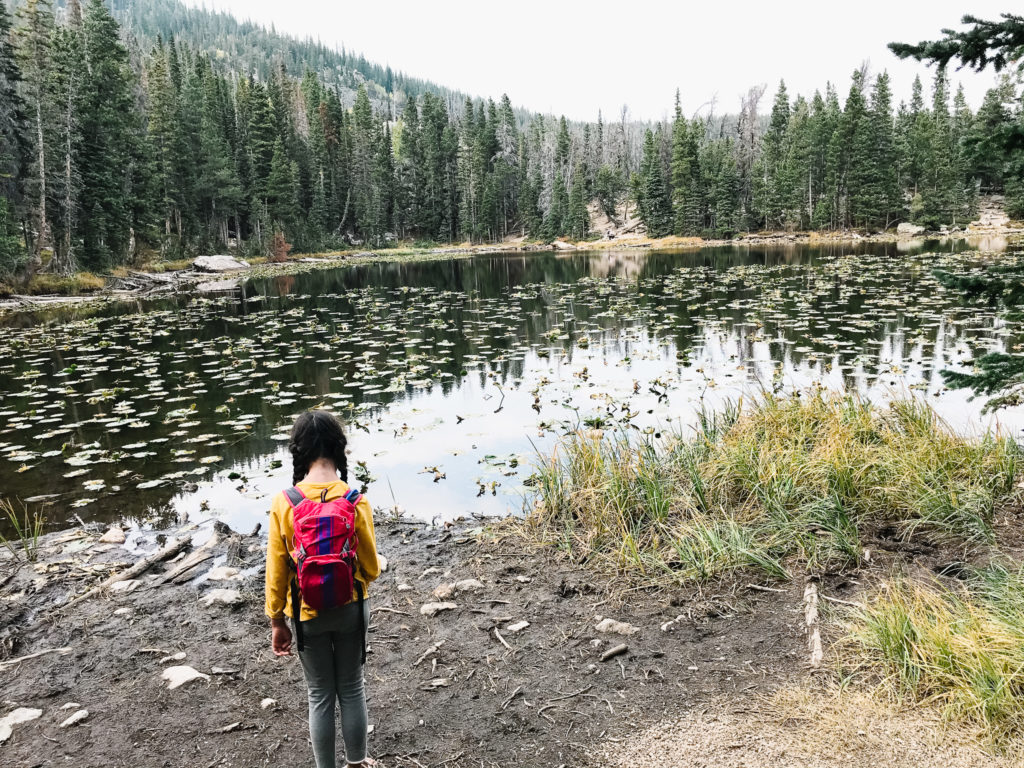
How To Get to Rocky Mountain National Park
It is easiest to get to RMNP by car. It’s a big park and nice to have a personal vehicle to drive Trail Ridge Road, which does not have shuttle bus access. That said, there is a wonderful shuttle bus system that will take you to many trails in the park. I highly recommend doing this to increase freedom and flexibility and also reduce congestion. There is also FREE public transportation from Estes Park that connects to the park’s shuttle system, as well as private tours that will take you on Trail Ridge Road.
Here are some distances to get to Rocky Mountain National Park from nearby cities and airports (but keep in mind that distances can vary greatly based on which part of the park):
- Boulder: 1 hour
- Denver: 1.5 hours
- Colorado Springs: 2.5 hours
- Grand Junction: 3 hours
- Salt Lake City: 7 hours
Where to Stay in Rocky Mountain National Park with Kids: Rocky Mountain Lodging for Families
Camping in Rocky Mountain National Park
There are 5 campgrounds within Rocky Mountain National Park. Camping makes it easy sightsee either by personal vehicle or by shuttle. RV camping is allowed in several of the campgrounds.
- Aspenglen Campground. Just inside Fall River Entrance Station near Estes Park. $30/night. 30 ft. RV length limit. Open in summer. 150 sites (4 ADA), reservations recommended.
- Glacier Basin Campground. On Bear Lake Road near Park & Ride. $30/night. 35 ft. RV length limit. Open in summer. 54 sites (2 ADA), reservations recommended.
- Moraine Park Campground. Near Beaver Meadows Entracne near Estes Park. $30/night ($20/night in winter). 40 ft. RV length limit. Open year round. 244 sites (3 ADA), reservations recommended (some open for first come, first served in winter).
- Longs Peak Campground. 20 miles south of Estes Park. $30/night. Tent only. Open in summer. 26 sites (0 ADA). First come, first served.
- Timber Creek Campground. Only campground on the west side of the park, 8 miles north of Grand Lake. $30/night. 30 ft. RV length limit. Open in summer and early fall. 98 sites (4 ADA). First come, first served.
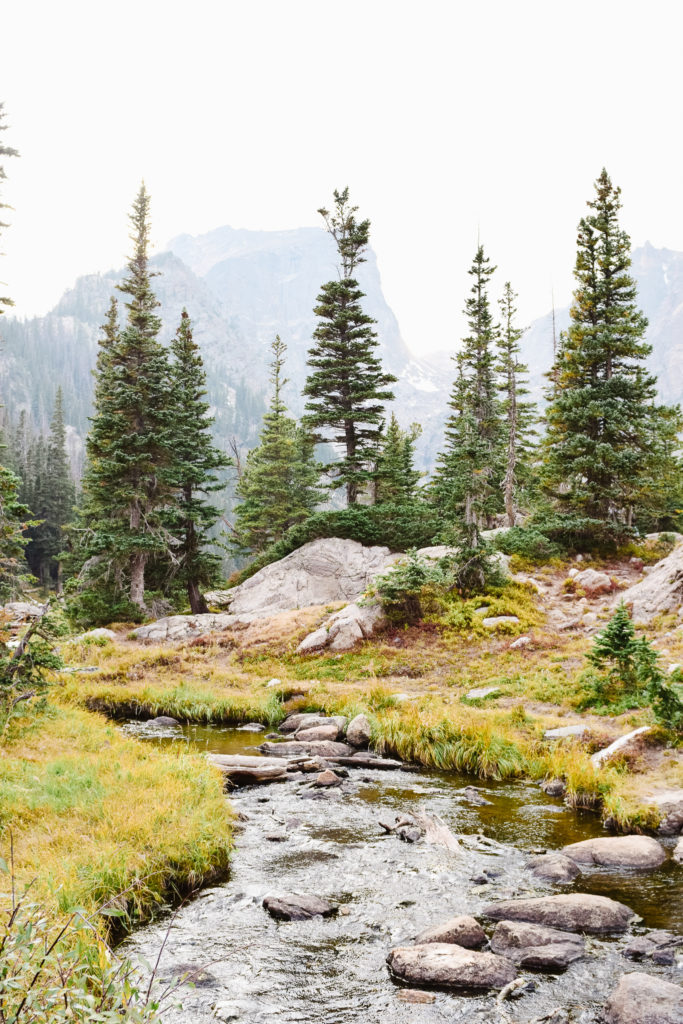
Tent Camping Gear
- CHOCKS. Chocks are super useful if the ground isn’t perfectly level. Makes it much easier to sleep when the vehicle is flat! They’re inexpensive and easy to use and definitely worth having on hand.
- HANGING SHOE RACK. An inexpensive shoe rack is my favorite RV hack – helps keep all the shoes organized and near the door, and helps keep dirt out of the vehicle.
- CAR BATTERY JUMP STARTER. This car jump starter is invaluable if the battery dies. It’s so nice to not worry about finding someone else to ask and lining up the vehicles. Super powerful and awesome. We have one we leave in the RV and one we leave in our minivan at home.
- TIRE INFLATOR & AIR COMPRESSOR. We once needed a roadside tire change on the RV, but the tech who did it didn’t have anything to inflate our spare tire for us! We were SO glad to have this on hand and now always leave one in both the RV and the car.
- PORTABLE POWER STATION BATTERY. I love having a small external portable charger (or this slightly larger and very powerful portable charger) for hikes, but this big power station is invaluable for powering up things in the RV (including running the heat overnight and charging devices).
- TRAVEL TOWELS. I adore these soft and lightweight travel towels. Way better than the microfiber kind and I love that everyone can have their own color so we don’t get them mixed up. They dry fast and are super absorbent.
- LIGHTWEIGHT CAMP CHAIRS. Part of the fun of either tent or RV camping is sitting out in nature, and these lightweight chairs make it more comfortable. These inexpensive kids camp chairs are also great!
- LIGHTWEIGHT VACUUM. I thought my husband was being fussy the first time he suggested bringing a vacuum in the RV. Turns out, we use it ALL the time to get out dirt and debris. This one is lightweight and easy to charge in the RV, but also super powerful. We love it at home, too, and it’s less expensive than the newer models. I also highly recommend having an inexpensive hand broom and dustpan.
Hotels Near Rocky Mountain National Park
There is no indoor lodging inside Rocky Mountain National Park but there are plenty of options in the gateway cities of Estes Park and Grand Lake.
Estes Park Lodging with Kids
Estes Park is the bigger of the two gateway cities to Rocky Mountain National Park, and is also closer to the major sites and attractions in the park. While it is certainly a touristy town (and has the kitschy shops and prices to show for it), it’s certainly beautiful (the mountains!) and most convenient. I recommend staying near the west side of town so you don’t need to drive through town to get to the park each day. Here are some lodging options:
- Hotels
- Hotel Estes. Free breakfast, swimming pool, fridge & microwave, playground, near Lake Estes Trail, snacks at reception, games, laundry, wifi. Family rooms available.
- Blue Door Inn. Free continental breakfast, pool & basketball court, lawn games, free wifi, games, laundry, fridge & microwave, every room has mountain views.
- Appenzell Inn. Free breakfast, swimming pool, wifi, family rooms, games, laundry, family owned.
- Home Rentals
- 2BR Condo Mary’s Lake – spacious, good location, beautiful deck, stunning views.
- Worldmark 2BR Condo – beautiful setting, just outside park entrance, cute cabin, fireplace.
- 3BR Condo – spacious and luxurious, fireplace, washer & dryer.
- RV Camping in Estes Park
- Spruce Lake RV Park (very close to the entrace)
- Estes Park Campground at Mary’s Lake (fantastic reviews)
- Estes Park KOA Holiday (great amenities)
Grand Lake Family Lodging
Grand Lake is on the west side of the park. It’s a bit quieter and more off the beaten path. While the scenery isn’t as dramatic, the lake views and bike riding are fantastic.
- Hotels
- Grand View Mountain Lodge. Near beach, patio with views, free wifi, restaurant.
- Historic Rapids Lodge. Near beach and river, free wifi.
- Home Rentals
- Lake View 2BR Condo. Sleeps 6, covered porch, dog-friendly.
- 3BR, 3 Bath Lakefront Condo. Sleeps 8, updated bedrooms & bathrooms.
- 1BR Top Floor Riverside Condo. Vaulted ceilings, loft, private balcony, sleeps 6.
- RV Camping in Grand Lake
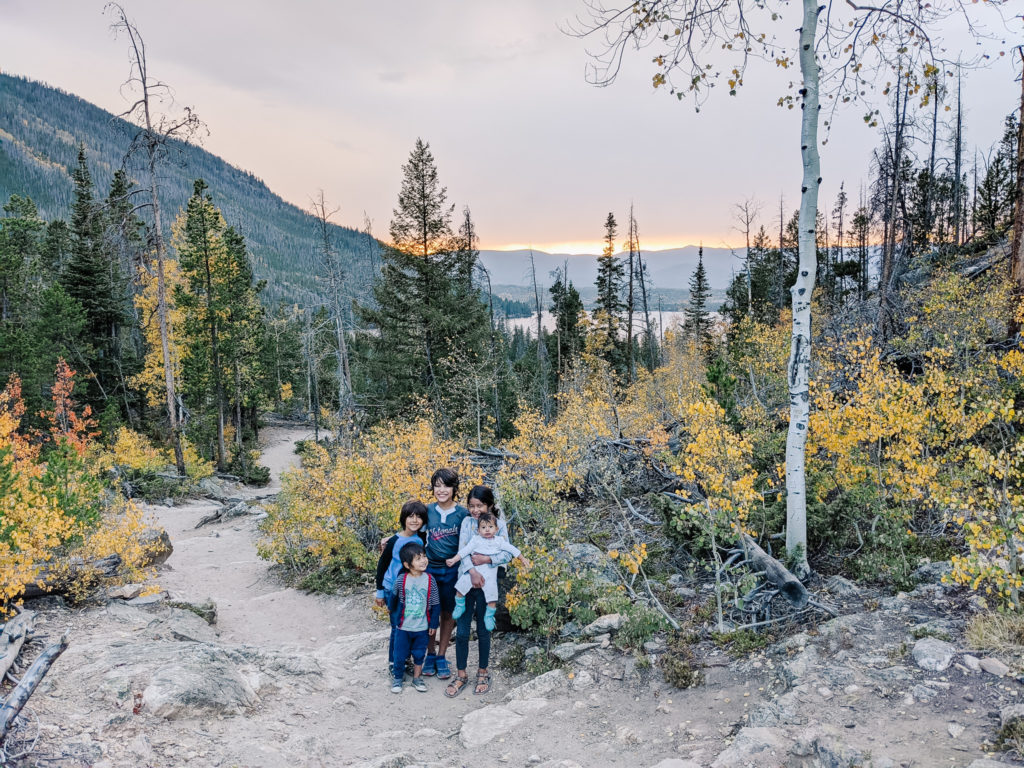
Where to Eat In Rocky Mountain National Park
There are no restaurants or eateries inside Rocky Mountain National Park. The Trail Ridge Store, near the Alpine Visitors Center, does have a few small snacks, but definitely plan to bring your own food and drink.
Estes Park has a number of great restaurants. We really enjoyed this Thai restaurant, and here’s a list of some other great places to eat near Rocky Mountain National Park.
Related: Our Favorite Vegetarian Camping Food (From a Lifelong Vegetarian)
How to Get Around Rocky Mountain National Park: RMNP Transportation
The easiest way to get in and out of Rocky Mountain National Park with kids is with a private vehicle.
Once inside the park, there’s a terrific (and free!) shuttle system that will take you along Bear Lake Road during the summer and early fall. This not only helps you avoid traffic and the hassle of parking, it also keeps the park less congested with vehicle traffic, and also allows you to do some connecting hikes without having to return to the same spot. I highly recommend taking the shuttle!
There’s also a completely free seasonal shuttle from Estes Park to RMNP. It’s a wonderful service provided by the city to help ease the congestion!
There are also a number of tours to Rocky Mountain National Park so you don’t need to worry about the driving OR the planning. Here are some good ones:
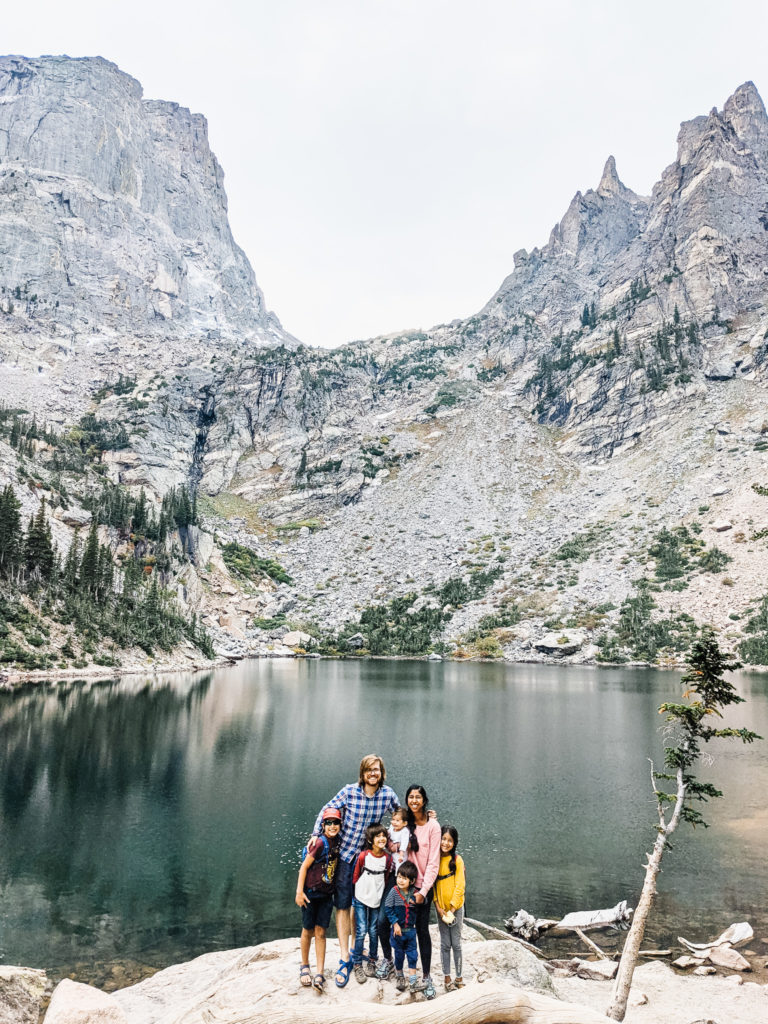
Best Time of Year to Visit Rocky Mountain National Park
As I mentioned before, the weather in RMNP can vary quite a bit by season, so you’ll want to make sure you pack appropriately whenever you go. That said, each season has its own magic!
Summer in Rocky Mountain National Park
Summer is, of course, the most popular. The days tend to be warm and dry with lots of sun, and isn’t typically scorching (especially at higher elevations). It’s also fun for getting out on the water if you wish. Wildflowers are everywhere! Summer also brings enormous crowds, however, as well as afternoon thunderstorms.
Fall in Rocky Mountain National Park
September is magical because it’s still quite warm (though the nights get quite chilly), but the crowds have mostly dispersed. The weather tends to be pretty consistent with little rain.
Spring in Rocky Mountain National Park
The spring, especially May, is amazing because the water is usually really powerful and awesome! I love seeing the waterfalls flowing full force. May weather can be dicey, though – snow is not unheard of!
Winter in Rocky Mountain National Park
Winter in Rocky Mountain National Park is also stunning in its own way. Snow is a given and is beautiful, though the amount varies by elevation. I wouldn’t tent camp in winter unless you have some serious cold-weather gear. It’s obviously the best time for skiing and snowshoeing.
Basically, with the right gear and clothing, Rocky Mountain National Park will be magical whenever you go!
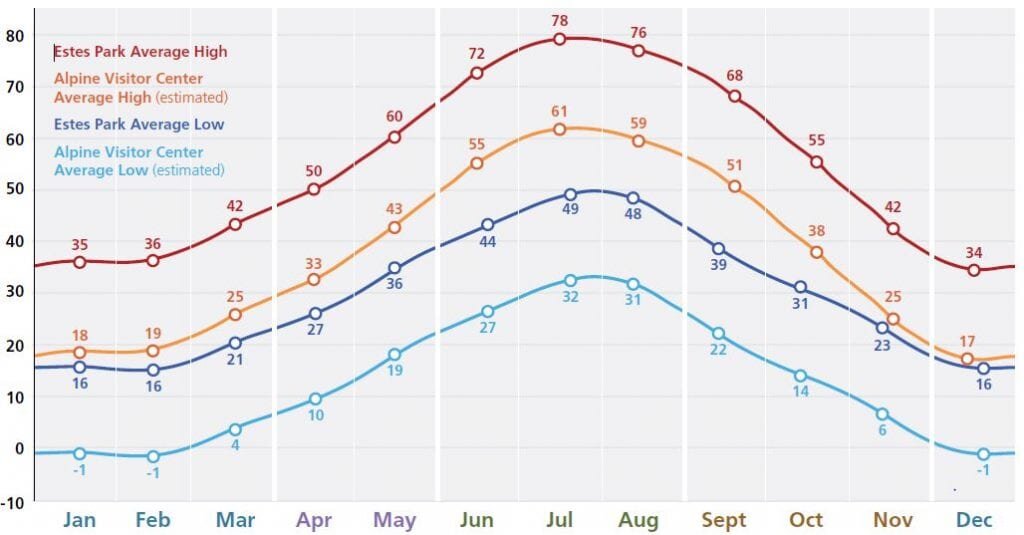
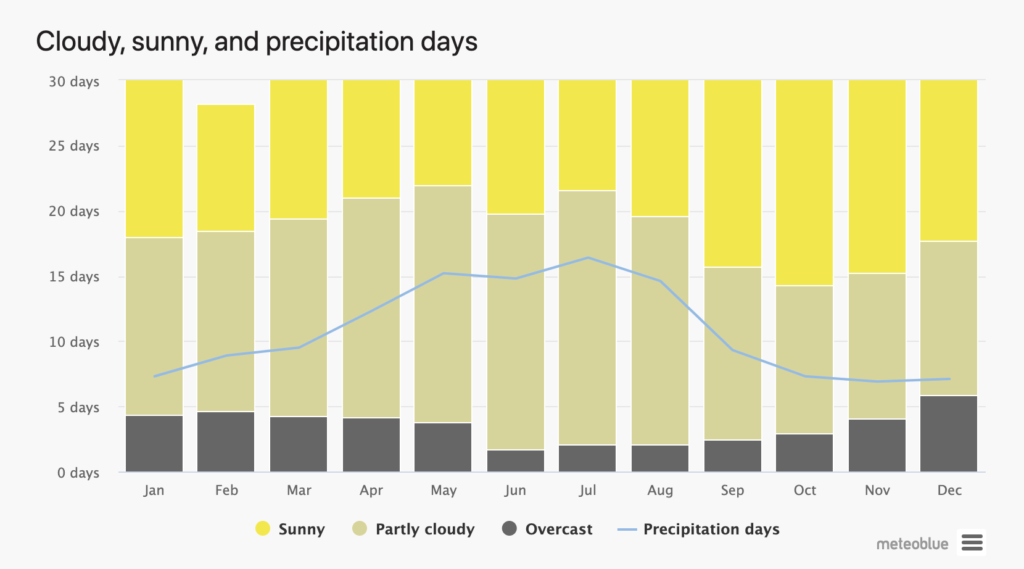
Easy Rocky Mountain National Park Hikes: Rocky Mountain National Park Hikes with Kids
There are so many easy Rocky Mountain National Park hiking trails! While you don’t have to hike to enjoy Rocky Mountain National Park, it’s definitely one of my favorite suggestions when planning what to do in RMNP since it can be great for families of all ages and abilities.
When hiking in RMNP, please be aware that the altitude can make a big difference in how strenuous a trail feels. If possible, take a few days to acclimate, and drink plenty of water. Be sure to take it easy with some shorter hikes to test out how you’re feeling before jumping into something really strenuous.
Bear Lake Nature Trail
Distance: 0.7 mile
Elevation Gain: 49 ft
Accessibility: first part of the trail is wheelchair accessible
Bear Lake is one of the most popular spots in the park, and for good reason. It’s absolutely beautiful, and the trail is short and flat enough to be a good option for a variety of abilities.
Emerald Lake Trail
Distance: 3.2 miles
Elevation Gain: 698 ft
Emerald Lake really gives you 3 lakes for the effort of one. You’ll start by passing the pretty Nymph Lake, followed by Dream Lake, where you’ll be wondering if it’s possible for a third lake to be any more green. Turns out Emerald Lake lives up to its name and is set in the shadow of Hallett Peak, a 12,700+ foot mammoth. The hike is short enough for newer hikers to complete while providing just enough challenge with elevation gain.
Again, beware of altitude sickness and pack plenty of water. Also be aware that this trail is very popular and thus crowded, so consider heading up very early or perhaps later in the day.
Coyote Valley Nature Trail
Distance: 1.1 mile
Elevation Gain: 29 ft
Accessibility: packed gravel; doable for strollers and wheelchairs
This easy trail is a perfect stroll through the meadows in Kawuneeche Valley on the west side of the park near Grand Lake. The packed gravel is doable for strollers and wheelchairs, and kids will love the river access.
Alpine Ridge Trail
Distance: 0.6 miles
Elevation Gain: 209 ft
After parking at the Alpine Visitors Center parking lot, head over to the stairs and up to the viewpoint. Though the trail is short, you’re climbing the entire time, and at 12k+ feet elevation, it feels a bit strenuous. Be sure to stay hydrated and take breaks if needed.
Alberta Falls Trail
Distance: 1.6 mile
Elevation Gain: 252 ft
This relatively short trail has a big reward with the stunning Alberta Falls. Though you’ll be to the side of the falls, it is super fun to feel its power and spray up there. There are plenty of rocks and places to sit for a snack and water break at the top, and it’s easy to connect to other trails in the area if you’d like to extend your hike.
Note that this trail is a great place to walk through groves of quaking aspens, especially stunning in the fall!
Adams Falls Trail
Distance: 0.8 miles
Elevation Gain: 104 ft
This beautiful 55-foot waterfall near Grand Lake on the west side of the park requires only a short trek to visit. The area is especially stunning in the fall as it’s filled with some deciduous trees that show off a variety of colors.
Other Easy RMNP Hiking Trails
Here are some other terrific trails with little ones!
- Sprague Lake Trail (0.8 miles, 39 ft elevation gain)
- Lily Lake (0.8 miles, 36 ft elevation gain)
- Alluvial Fan East Trail (0.5 miles, 157 ft elevation gain)
- Tundra Communities Trail (1.1 miles, 175 ft elevation gain)
- Cub Lake (2.3 miles, 540 ft elevation gain)
- Bierstadt Lake Loop Trail (3.2 miles, 626 ft elevation gain)
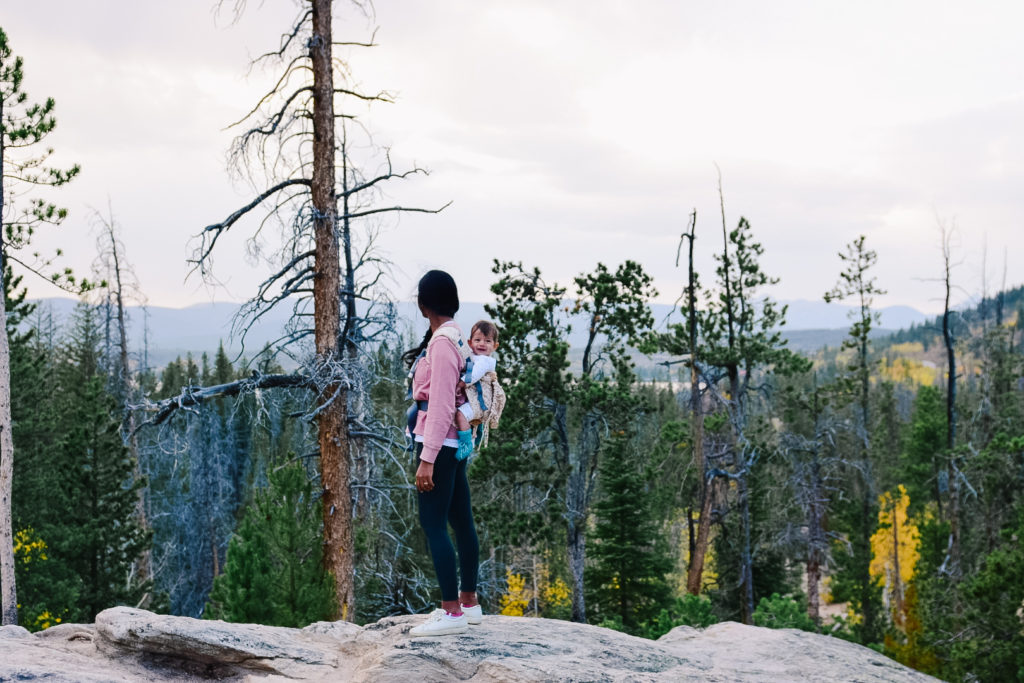
Hiking in RMNP with Older Kids
While most of the hikes above are accessible to kids and families of all ages, here are some other hikes that may suitable for older kids or ambitious families. These are definitely hikes that require some experience and stamina, and are great for older, more experienced children (generally middle school+):
- Mills Lake (5.3 miles, 780 ft elevation gain)
- Ouzel Falls (5.4 miles, 960 ft elevation gain)
- Timberline Falls (7.55 miles, 1,371 ft elevation gain)
- Deer Mountain (6 miles, 1400 ft elevation gain)
- Bluebird Lake (12 miles, 2,478 ft elevation gain)
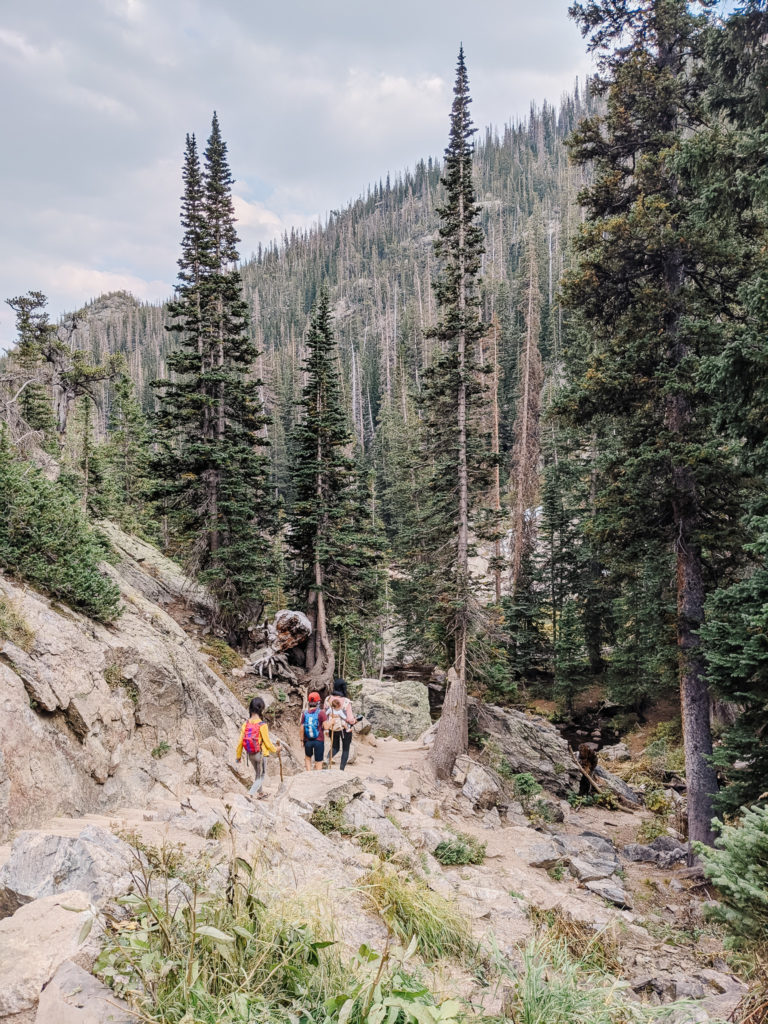
Best Rocky Mountain National Park Viewpoints
There’s no shortage of amazing viewpoints in Rocky Mountain National Park. It seems around every turn is another incredible vista! Here are some of our very favorites:
- Bear Lake
- Popular for a reason. Go early to catch the water very still so you can see the reflection of the trees and mountains.
- Moraine Park
- Catch meadow views with the river and hopefully some elk.
- Trail Ridge Road
- There’s an incredible view around every single curve. Some of the best views on Trail Ridge Road are Many Parks, Forest Canyon Overlook, Farview Curve, Gore Range Overlook, and Rainbow Curve
- Sprague Lake
- A wider expanse than Bear Lake, this one is especially pretty with sunrise colors.
- Alpine Visitors Center
- If you walk up to the top of the Alpine Ridge Trail, you’ll get a beautiful, expansive view of alpine tundra.
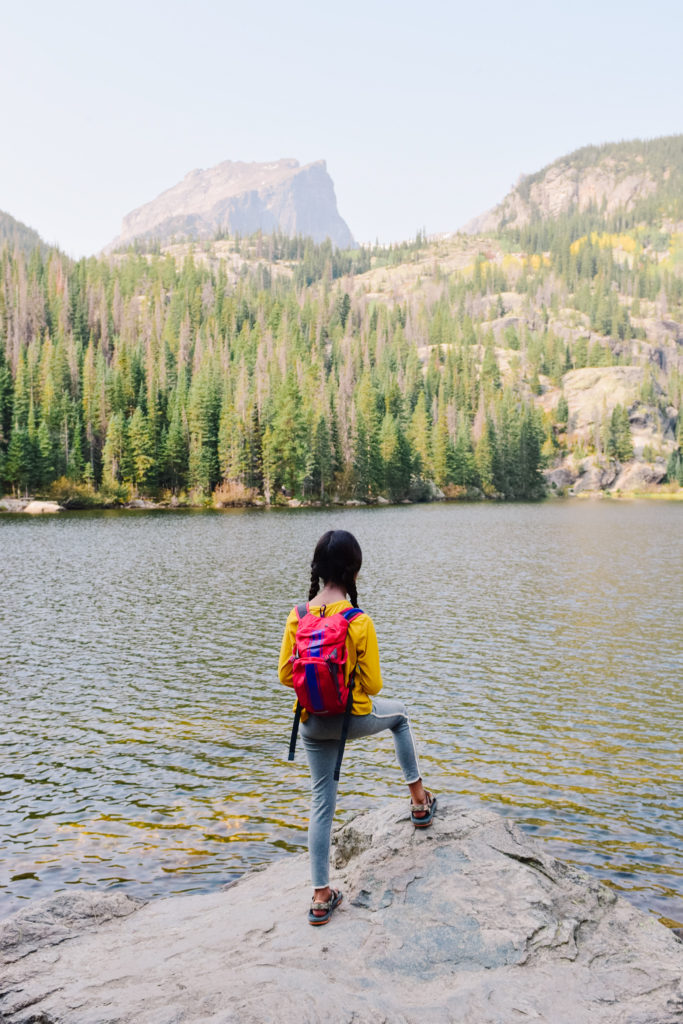
What To See in Rocky Mountain National Park: Top RMNP Checklist
If you have limited time and are wondering about the top things to see in Rocky Mountain National Park, here are some of the best things to see in RMNP:
- Go on a hike (I recommend Emerald Lake or the Alpine Ridge Trail if you’re short on time)
- Drive Trail Ridge Road, the highest continuously paved road in the US, through the alpine tundra (take warm clothes for the top, and check road conditions beforehand)
- Look for wildlife (check out Moraine Park)
- Cross the Continental Divide
- Look out at some overlooks (I recommend Forest Canyon Overlook)
- Attend a ranger program
- Have a picnic
Other Things to Do in Rocky Mountain National Park with Kids: Fun Activities in RMNP
If you’re still not convinced and are wondering, “Is Rocky Mountain National Park kid friendly,” here are a bunch of other activities that are perfect for a Rocky Mountain family vacation:
Junior Ranger
The RMNP Junior Ranger program is really well done with an interesting and in depth booklets for three different age ranges. There’s even a Junior Ranger headquarters, where you can attend ranger programs, complete your booklet, and earn your badge. You may also turn in your booklet at any other visitors center to earn your badge.
You can also print out digital Junior Ranger booklets in English and Spanish, as well as coloring pages, right here on the National Park Service website.
Wildlife Viewing
Wildlife viewing is one of the very best Rocky Mountain National Park activities. It’s truly one of the best spots in the country, or even the world! Some of the best animals are elk (elk rut in the fall is amazing but you can see them anytime), bighorn sheep, moose, mule deer, and more. PLEASE be careful to stay far from wildlife, do not leave any food or trash, and do not interact with them in any way.
Here’s where to see wildlife in Rocky Mountain National Park:
- Moraine Park
- Sheep Lakes
- Kawuneeche Valley
- Tundra areas – marmots, foxes, and more
Here are more tips on where to view wildlife as well as wildlife safety.
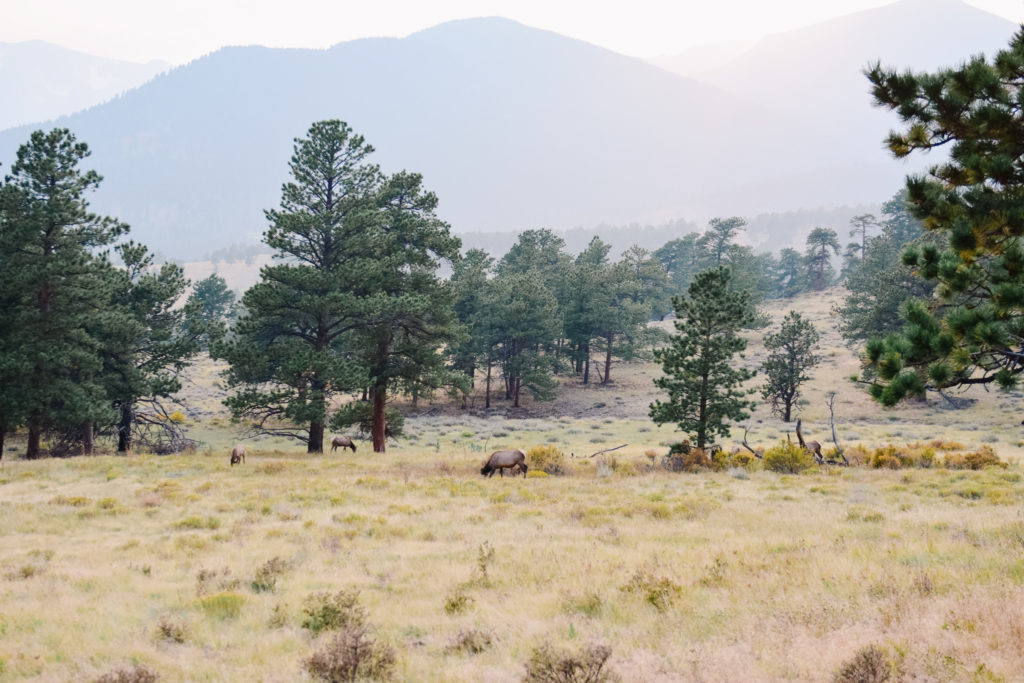
Scenic Drives
RMNP has a well developed road system so it’s easy to see a lot by vehicle. Trail Ridge Road is a truly stunning way to take in diverse ecosystems, from montane (lowland) to subalpine to alpine. It’s the highest National Park Road and allows you to traverse alpine tundra by vehicle. There are also plenty of pullouts so you can take in the terrain a bit more slowly. It’s truly breathtaking and should absolutely be on your list of things to do in Rocky Mountain National Park with kids.
Old Fall River Road is a one-way, mostly gravel 11-mile road filled with switchbacks. The NPS website describes it as a “motor nature trail” – it’s much more rustic than Trail Ridge Road but allows visitors to see what a park experience may have been like decades ago.
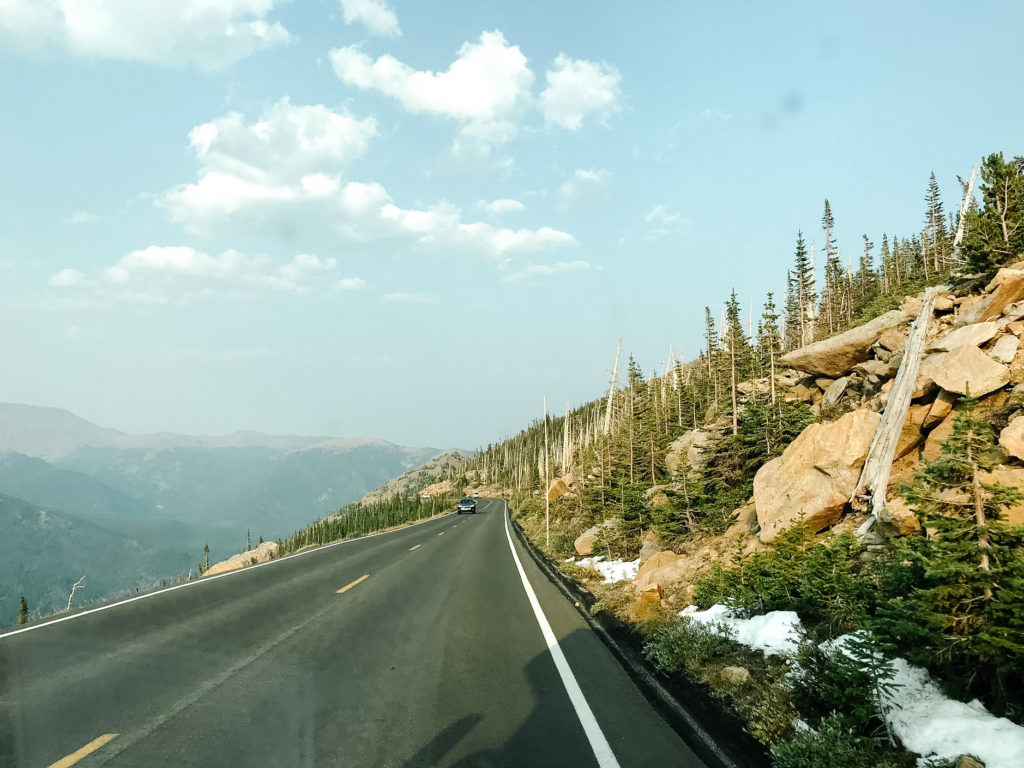
Water Play
Fishing is historically a big part of the RMNP experience, and visitors can still participate today. See the NPS website for info on fees, licenses, locations, and other rules.
If you’d like to get out on the water, Grand Lake is the best place to start. There, you can kayak, raft, sail, pedal boat, or swim.
Snow Play + Winter Sports
On the other hand, if you’re looking for things to do in Rocky Mountain National Park in December or planning for Rocky Mountain National Park in winter, snow play can be really fun for little ones and grown ups alike! While the lower elevation points don’t get tons and tons, it’s certainly enough for some snow play.
Just be aware of Rocky Mountain National Park winter road closures – Trail Ridge Road closes for the season in the fall, and even may have a quick closing in early summer for snow.
If you’re up for something a bit more, there’s fantastic snowshoeing and skiing all around. Perfect for adventurous souls!
Biking in Rocky Mountain National Park
Biking is allowed on most paved roads in RMNP, but they do not have protected bike paths, so I would not recommend them for families with children.
However, the Grand Lake area has a 2-mile stretch of the East Shore Trail that is both protected and available for bike usage. It’s a perfect spot for a family bike ride!
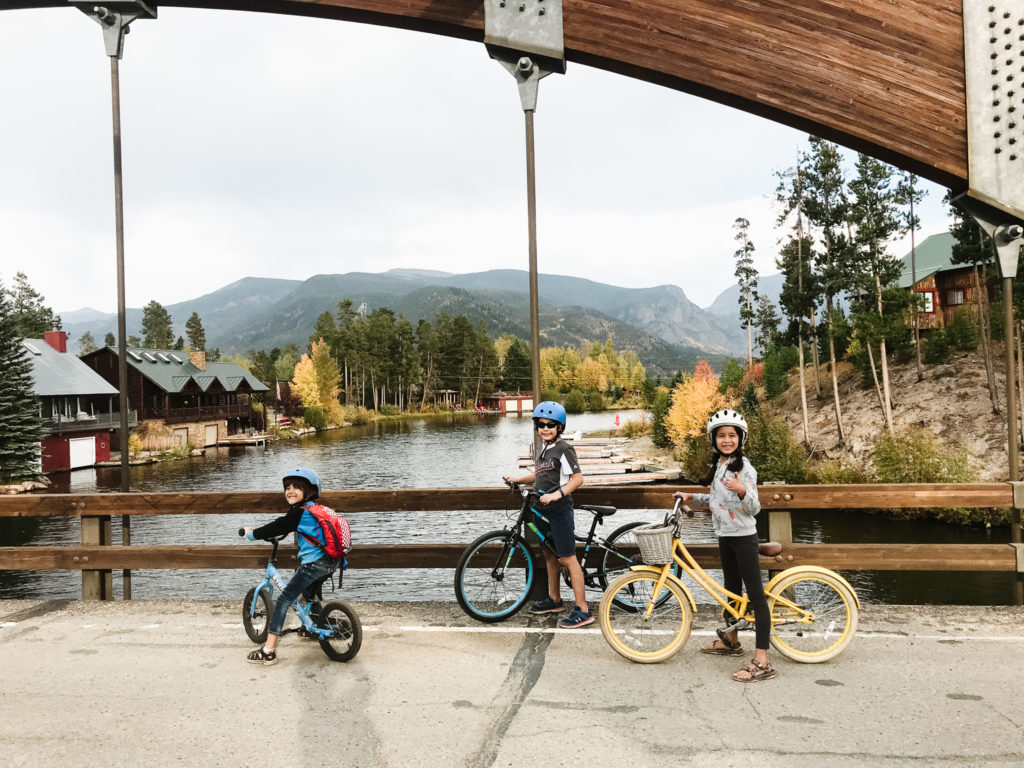
Horseback Riding in Rocky Mountain National Park
Did you know you can horseback ride in Rocky Mountain National Park? Over 95% of the park is designated wilderness, so there’s plenty of space to ride. You can find info on stables and trails on the NPS website. There are also organized tours that will lead you!
Photography
There’s something so incredible about the massive peaks in the Rockies. A photography tour is the perfect way to learn more about scale and composition when capturing them. Astrophotography is especially fun – here’s a great astrophotography tour to help you learn the basics.
Rock Climbing (or Watching!)
Rocky Mountain National Park is known for having some of the best rock climbing in the world. It’s like a natural playground! Little ones will love scaling some big boulders, and more experienced individuals can do some technical climbing on their own or as part of a tour group when visiting RMNP.
If climbing isn’t your thing, it’s still super fun to watch others do it! Sit back and watch experienced climbers as they scale enormous rock formations.
Picnicking in Rocky Mountain National Park
Perhaps you just want to chill and take in the surrounding beauty – Rocky Mountain National Park is great for that, too! If you prefer to just relax and enjoy nature, I recommend packing a picnic and heading to Moraine Park. You’ll be surrounded by spectacular views and plenty of open space. It’s one of our favorite things to do in Rocky Mountain National Park with toddlers! Here’s more info on where to prepare hot food.
Work on Survival & Safety Skills
Being out in nature is a perfect opportunity to work on some survival and safety skills. Think, first aid, pocketknife skills, knot tying, review water safety, food storage (using bear boxes and bear safe trash cans!), and hiking safety (always stay with a buddy and leave no trace).
Here’s a list of survival and safety skills for kids that you can review whether backyard camping or heading out into nature!
Take A Day Trip
If you have extra time, there are plenty of opportunities for day trips from Rocky Mountain National Park, as well. Vail in the summer or winter is a fantastic destination whether you have younger or older kids and is about 2.5 hours away. Lyons is much closer and only about 30 minutes from Estes Park. There are tons of other options, as well!
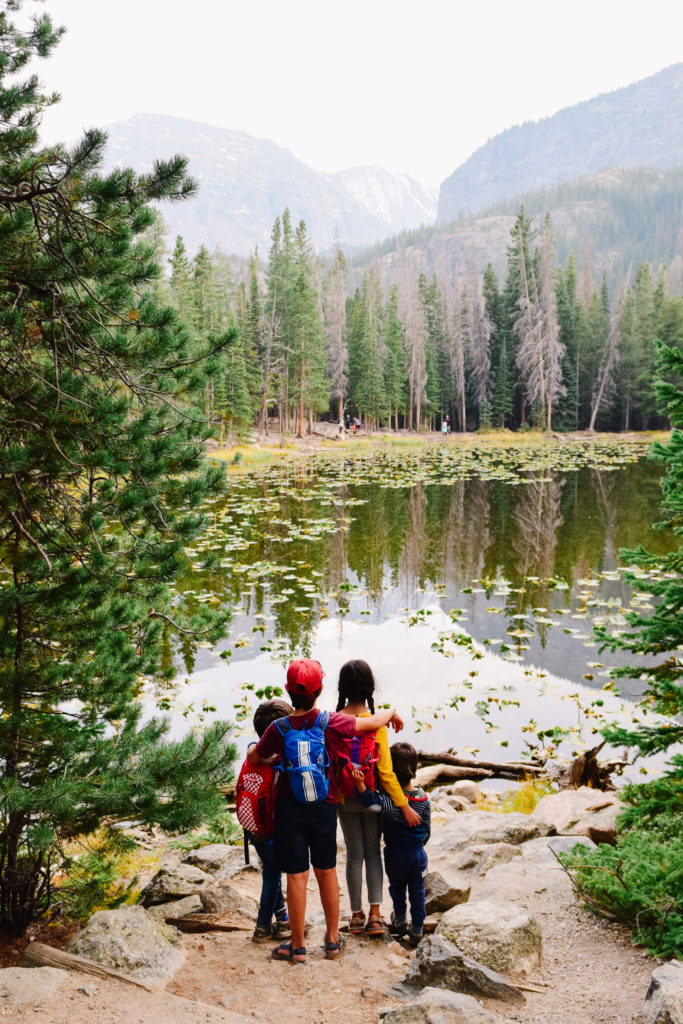
Rocky Mountain National Park and Videos and Movies About RMNP
These are some fantastic videos for a Rocky Mountain National Park virtual tour!
Enjoy Your Visit to Rocky Mountain National Park with Kids!
We’ve loved putting together this Rocky Mountain National Park travel guide to take an in person or virtual visit to Rocky Mountain with kids. We’d love to hear if you do any of these activities for a on a family trip to RMNP!
We hope to inspire curiosity and connection through exploring and learning, and we hope this guide helps you and your families. Please share any activities you do with us over on our Instagram. And we’d be delighted if you passed this guide to RMNP with kids along to others, as well!
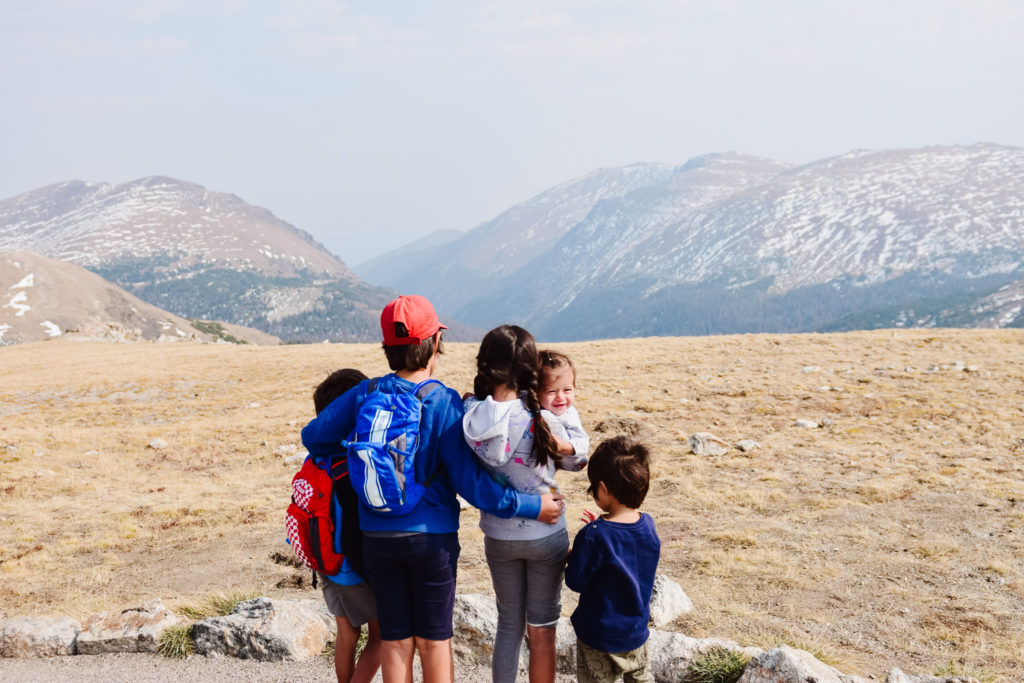
MORE POSTS
IF YOU LIKED THIS POST ABOUT VISITING ROCKY MOUNTAIN NATIONAL PARK WITH KIDS, YOU MIGHT LIKE THESE POSTS TOO:
- 7 Tips for Enjoying Hiking with Kids
- Ultimate Guide to Backyard Camping (Including Safety Skills Activities)
- A Winter Visit to Zion National Park
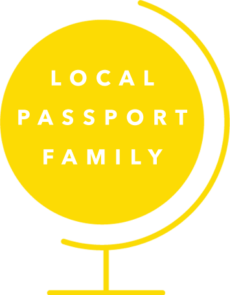








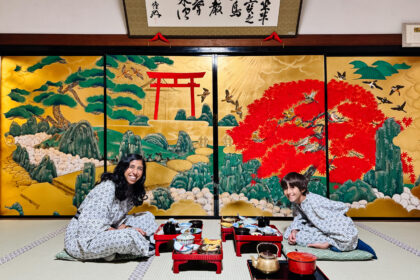
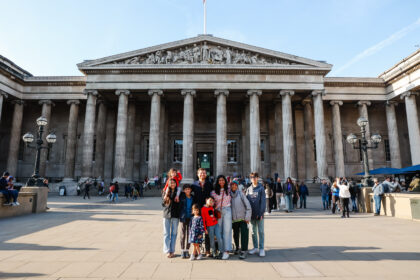







[…] it comes to traveling with a variety of ages and abilities, Rocky Mountain National Park (RMNP) is a fantastic choice. With an abundance of activities beyond those requiring intense […]
[…] For those who aren’t interested in hiking Rocky Mountain National Park also boasts the highest paved road in the continental United States. Trail Ridge Road takes you right up into the alpine tundra up to an altitude of over 12,000 feet. Perfect for enjoying views with napping babies or tired kiddos. You’ll spot all kinds of wildlife along the way, and it’s very neat to see how it changes along the way. Then head back down into the valley to spot some of the bigger animals! For more info, here’s a full guide to visiting Rocky Mountain National Park with kids. […]
[…] for other National Parks to visit with your kids? Consider Rocky Mountain National Park, Great Smoky Mountains National Park or Yellowstone National […]
[…] Ultimate Guide to Rocky Mountain National Park […]
[…] Speaking of western national parks in the state of Colorado, another national park we loved visiting during our national park roadtrip this summer was Rocky Mountain National Park. Located in north-central Colorado, Rocky Mountain National Park is home to all kinds of animals, including bears, bighorn sheep, and elk. The popular Trail Ridge Road reaches a height of 12,000 feet above sea level! Rocky Mountain National Park has plenty of beautiful hikes for little ones. If you're looking for ideas, Local Passport Family put together a great guide for Rocky Mountain National Park with kids. […]